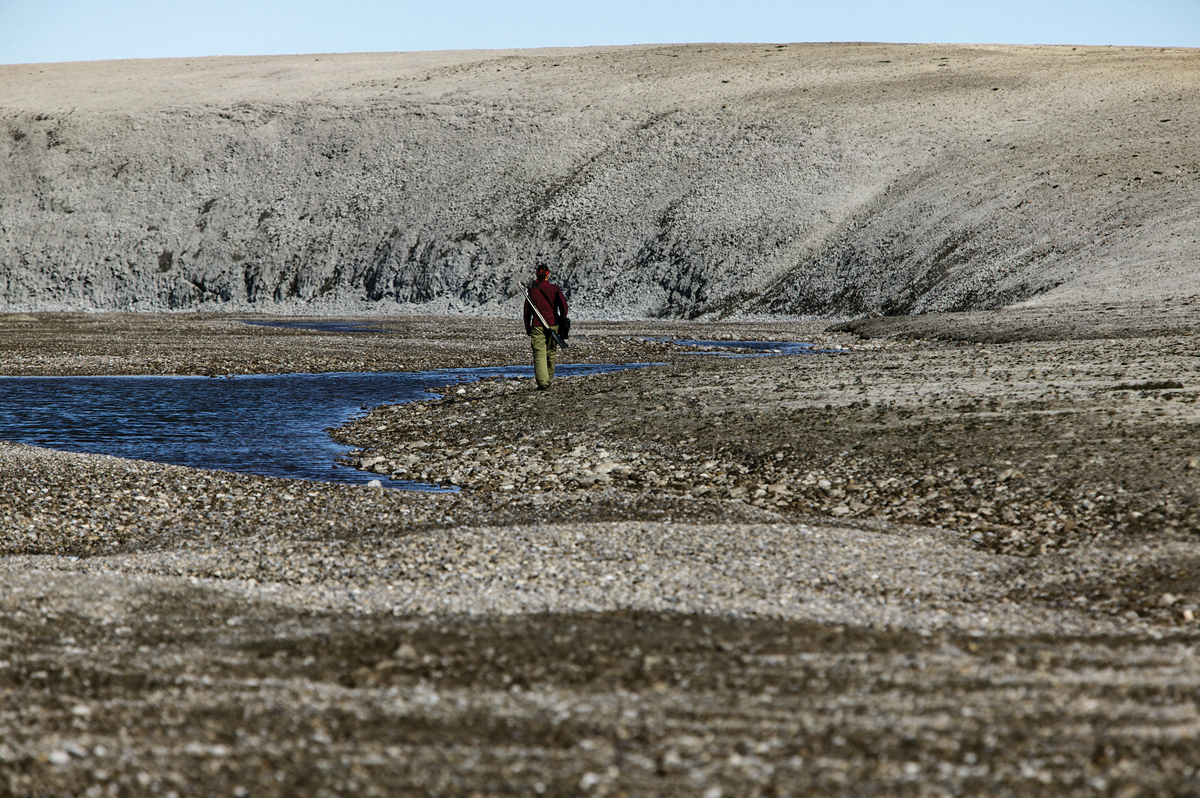Credit: Martin Lipman
Researchers have sequenced proteins from an ancient rhino relative from the cold, dry Haughton crater site (shown) in the Canadian Arctic. They are some of the oldest enamel sequences reported.
Peptides may be able to survive in the enamel of teeth that are tens of millions of years old. Two independent studies have reported on proteins found in ancient teeth, have provided the oldest sequences useful for working out evolutionary relationships between creatures. These proteomes are up to 24 million years old. Both studies were published July 9 in Nature (DOI: 10.1038/s41586-025-09040-9, DOI: 10.1038/s41586-025-09231-4).
“This is all very exciting stuff,” says Evan Saitta, a paleontologist at the Field Museum of Natural History who didn’t work on either paper.
Researchers often rely on observations of the size and shape of bones to place long-extinct animals into family trees. But that can be tricky. And while researchers could use DNA, the oldest DNA extracted from a large fossil— from a sample found in the Arctic—is around 1.2 million years old. But proteins can typically stick around longer than DNA and could provide a source of molecular data to work out evolutionary relationships that fossil morphology can leave unclear, Saitta says. Until now, the oldest confirmed sample to yield protein data for taxonomy is a 3.7-million-year-old collagen from a camel relative.
University of Copenhagen biomolecular paleontologist Ryan Paterson and colleagues reasoned that they might be able to find more ancient proteins if they could target not only the perfect locale for preservation—the frigid high Arctic—but also the most promising tissue: enamel. “That super hard, rigid surface that surrounds our teeth,” he says, “could potentially act as a perfect scaffold for these proteins to survive over long time periods.”
Paterson’s team profiled the proteins from a fossil tooth fragment from an ancient rhino relative that was pulled from the permafrost in northern Canada. This roughly 22-million-year-old enamel yielded around 1,000 peptide matches—enough to place it in its family tree. The proteins had sustained modifications and damage, as expected for ancient proteins. “This is probably the most degraded proteome that we have had access to yet that we can still use for all these purposes,” Paterson says. The taxonomic information from the proteins supports the idea that an important split in the rhino family tree happened more recently than researchers once thought.
In another study, researchers looked at 10 fossil teeth, ranging from 1.5 million to 29 million years old, from the Turkana Basin in Kenya. “This is one of the harshest environments on the planet,” says mass spectrometrist Timothy Cleland of the Smithsonian Institute and one of the study’s authors. But it’s also a very important area for studying the evolutionary origins and diversification of animals such as the relatives of elephants, rhinos, hippos and hominins, he adds.
The oldest samples in which the researchers were able to identify peptides are the tooth of an 18-million-year-old rhino relative and 16-million-year-old teeth from three types of proboscideans, a group of elephant relatives. This information could someday help make sense of the ancient elephant family tree, says Daniel Green, a paleontologist at Harvard University and coauthor of the paper. “There’s an enormous amount of controversy among paleontologists about what the evolutionary relationships are between these different proboscidean taxa.”
In teeth, enamel proteins occur in close association with the biomineral hydroxyapatite. “I’m actually not surprised that you can get proteins preserved on mineral surfaces,” says Karina Sand, a biogeochemist at the University of Copenhagen who wasn’t involved with either study. In separate research, Sand and colleagues sequenced the oldest DNA yet—2-million-year-old molecules stuck onto sediments. She and other researchers are exploring how chemistry mediates the interaction between minerals and proteins. But the age of the proteins found in these new reports—over 15 million years—is surprising, Sand says.
The two papers differ in some of the techniques used. Those used on the rhino relative from Canadian permafrost are more typical for paleoproteomics studies. The methods are “rock solid,” says Ghent University proteomics expert MaartenDhaenens, who wasn’t part of either project. “It’s very convincing.” The other study reporting proteins from mammal fossils in the Turkana Basin used “a less conventional methodology, and it might require some more verification,” Dhaenens says.
Protein preservation in cold environments is easier to explain. “If you’re going to find old peptides, the higher latitudes or the colder temperatures are definitely where you’d want to look,” Saitta says. But, he adds, if proteins can last for millions near the equator, future research should be able to find proteins of this age in other environments around the world.
Chemical & Engineering News
ISSN 0009-2347
Copyright © 2025 American Chemical Society
